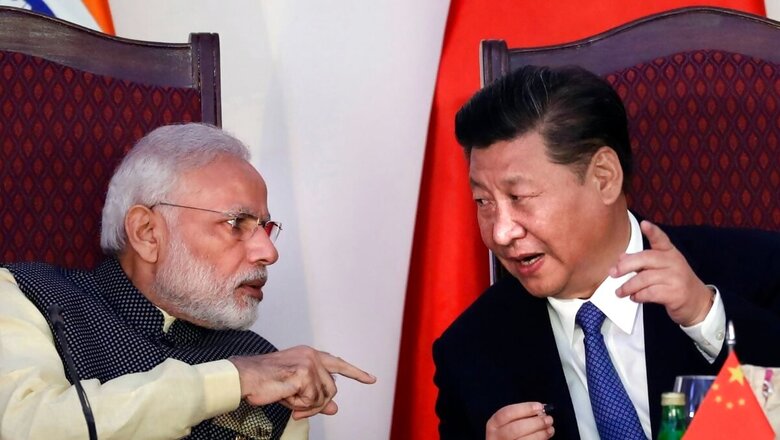Straight Talk | India’s Himalayan Powerplay: China Caught Off Guard As India, US Play the Tibet Card

views
The new Indian government was sworn in on June 4. Within days, a bipartisan American delegation led by the US House Committee on Foreign Affairs chair Michael McCaul was in town. The town in question was Dharamshala – the seat of the Tibetan government in exile and where the Dalai Lama has been living ever since he fled Tibet. Despite China’s warnings to Washington against the said visit, the American delegation met Prime Minister Narendra Modi in Delhi after their talks with the Tibetan government and the Dalai Lama. That Nancy Pelosi is a personality deeply embedded in the American establishment is a well-known fact. As such, her visit had to have the sanction of the top echelons of both the Biden administration and the Modi government. Her visit to Dharamshala was, for all practical purposes, as significant as her trip to Taiwan in 2022, if not more.
Naturally, this has made many in India and around the world sit up and take notice. After all, Washington and New Delhi’s Tibet push has come out of the blue. On expected lines, the intention of the visit has come under scrutiny. China is flummoxed, while many in India appear to be apprehensive of the Americans using New Delhi as a shoulder to fire from. However, this is certainly not a haphazard decision by India, much less one taken under pressure. It is a warning shot for China and its president, Xi Jinping. India is essentially signalling to China that play-time is over. The scare of falling out of line vis-à-vis the “One China Policy” is over. One-sided bullying will no longer allowed to be the norm. China can no longer rename Indian villages and expect New Delhi to sit by idly. The rules of engagement have changed.
It was about time India let China know that it too can press some of Beijing’s raw nerves. While caution is advisable, it is refreshing to see India demonstrate the ability to play the game as an equal power. Bullying tolerated beyond a point is as good as submission. As a side note, it is surprising to watch the US take up the issue of Tibet’s autonomy so aggressively. The US appears to be trying to gain leverage over Beijing in the run-up to it making a move on Taiwan. The invasion of Taiwan looks inevitable, and is only a question of “when” and not “if”. Joe Biden also has good reason to push the Tibet card now, at the fag end of his Presidency, given how American foreign policy since 2020 has been an unmitigated disaster. If this indeed turns out to be the first and last Biden presidency, he would like to end it on a high note and be seen as a President who brought Tibet back on the table.
For India, China’s growing appetite for expansionism is quite concerning. Beijing has been upping the rhetoric on “South Tibet”, renaming Indian villages and refusing to disengage from crucial areas in Ladakh. It is also expanding its outreach in the Indian Ocean Region (IOR) and attempting to lure traditional India-friendly countries under its umbrella. For India, the worry in a post Taiwan-invasion scenario will be where China turns its eyes next. Chances are, Beijing’s focus will turn to Arunachal Pradesh and Ladakh even as it steps up activities in the IOR.
India does not want to be taken by surprise and left devising a strategy when the crisis strikes. By allowing the US delegation to not just visit Dharmshala but also meet the Dalai Lama, the Indian government has made it clear it can also play the Tibet and Taiwan cards at a time and place of its choosing.
That the same has happened at the very outset of Modi’s third term in power is quite telling as well. It is a sign from the Indian government that China will be taken head on over the next five years.
The US has orchestrated a big show of strength alongside India in order to publicise the bipartisan Tibet policy bill. After all, the visit came in the backdrop of Biden preparing to sign the Tibet policy bill adopted by both the US Senate and the House of Representatives. The bill seeks to counter China’s narrative about its control over Tibet and promote dialogue between the Chinese government and the Dalai Lama.
The Tibet Policy Bill refutes China’s claim that Tibet has been part of China since ancient times. That, in Beijing’s mind, is a direct affront to the “One China Policy” – something which India is now party of.
WHAT PROMPTED THE CHANGE IN INDIA’S STRATEGY?
There are a couple of factors playing on India’s mind. First, China and India are both engaged in an active standoff in Eastern Ladakh. Beijing wants India to accept the new status quo in Ladakh and allow the bilateral relationship to remain unaffected. However, New Delhi is willing to have none of it and insists that absent a resolution in Ladakh, the bilateral relationship will remain in the cold storage.
For far too long, India has had a headless and incoherent policy of dealing with China. Finally, one can witness signs of New Delhi getting its act together and a much more strong-headed and mature China policy taking shape – one which will become even more apparent and concrete in the months to come. Moves relating to Taiwan and Tibet appear to be part of the same strategy, which India is now using to gain leverage over China.
China’s recent gesture of gifting water to the Maldives from Tibetan glaciers, while hypocritically promoting water conservation campaigns, has not gone unnoticed. In response, New Delhi is preparing to rename 30 villages in Tibet, as a form of diplomatic retaliation. The message for China could not be any clearer.
China claims Arunachal as its territory by referring to it as ‘Zangnan’ or southern Tibet. It has renamed 30 locations in Arunachal Pradesh with Chinese and Tibetan names. This appears to have been the last straw for India. Not only is China refusing to expeditiously resolve the standoff in Eastern Ladakh, but is also consistently pushing its own narrative on Arunachal Pradesh by calling it “South Tibet”.
READ MORE | China’s Map Wars: Time for India to Stand Up for Tibet and Taiwan
Besides, only months prior to India hosting the G20 leader’s summit in New Delhi last September, Beijing had released a new map that asserted territorial claim over Arunachal and Aksai Chin in Ladakh. In the 2023 edition of China’s ‘standard map’, uploaded by its ministry of natural resources on the website of its standard map service website, Aksai Chin and Arunachal are among the south and south-east Asian territories marked within the Chinese borders. Add to it China’s growing eye in the Indian Ocean Region, and India believes the time to take concrete action is now.
India has finally realised that China is not a country that can be ignored. Beijing’s expansionist tendencies know no bound. There will not suddenly come a day when China forgets all about its fictitious claims on Ladakh, Arunachal Pradesh and other sovereign Indian areas. For now, India has made it abundantly clear to China that unless it course-corrects, New Delhi’s activism for both Taiwan and Tibet will only rise. In the times to come, one can expect more facets of this Himalayan powerplay to unfold.




















Comments
0 comment